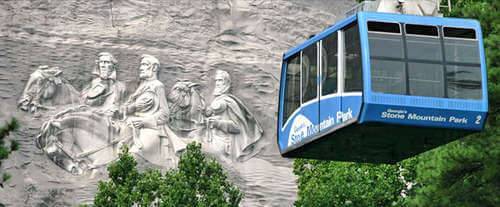Sanitizing White Supremacy
Author: Matt O'Donnell
Published: 08.15.17
When I first started teaching twenty years ago, I worked in a suburb of Atlanta, Georgia. Not far from where I lived was the popular tourist attraction of Stone Mountain Park. Many of my eighth grade students would talk about the “cool laser light show” there. Families would bring a picnic and watch the laser show which included cartoon depictions sports figures and American flags; the show was accompanied by patriotic music. The light show also included glorified renderings of three Confederate figures: Jefferson Davis, Robert E. Lee and Stonewall Jackson.
I was especially shocked that people would bring their families to celebrate those that rebelled against the United States in defense of slavery and white supremacy. New generations of children were being told a sanitized version of history, for nowhere in the laser light show was shown the institution of slavery nor the dark history of Stone Mountain.

Stone Mountain was the site of the rebirth of the KKK in 1915. One year later, the Daughters of the Confederacy commissioned a relief carving of Jefferson Davis, Robert E. Lee, and Stonewall Jackson into the side of the mountain. The KKK was given perpetual rights to meet on the mountain until the State of Georgia purchased the property in 1960. Now the park is the most popular tourist attraction in Georgia, it offers field trips for schools and even a teacher's guide void of the true history of the site.
As teachers and as parents it is easy to fall victim to the sanitizing of our history through what we include and what we leave out of our lessons. From the outfits students create to celebrate Thanksgiving in kindergarten classes to the textbooks we have our students read we risk continuing to sanitize white supremacy. Covering all content in a superficial way can actually give students a worse understanding of history.
The new California Social Science Framework calls the use of many different resources to help students understand history.
“Teachers carefully select documents that will engage their students in historical thinking, geographic practices, and economic reasoning. The teacher can introduce students to a wide array of primary sources that include written texts and letters; excerpts of speeches, diaries, and ledgers; visual materials such as photographs, paintings, maps, political cartoons, charts, and graphs; digital materials; and oral histories.”
By acting like historians, teachers and students are able to dig deeper into events of the past and discover more accurate details. This is a great opportunity for educators to help their students find areas where history is being sanitized and create an accurate narrative of our past.
Below is a list of sites to find primary sources:
California History
California Historical Society https://www.californiahistoricalsociety.org/research/
California Resources from the Library of Congress http://www.loc.gov/teachers/classroommaterials/primarysourcesets/states/california/index.html
California Primary Sources from the UCSD Library http://ucsd.libguides.com/c.php?g=90745&p=1849761
Calisphere - Digital Resources from the University of California Libraries https://calisphere.org/
U.S. History
Digital primary source collections from the Library of Congress https://www.loc.gov/collections/?fa=subject%3Aamerican+history
Lesson plans using primary sources from the Library of Congress http://www.loc.gov/teachers/classroommaterials/lessons/ Grades 3-12
Smithsonian Source http://www.smithsoniansource.org/display/primarysource/search.aspx
National Archives https://www.archives.gov/research
Primary sources organized by Sam Houston State University http://www.shsulibraryguides.org/c.php?g=86715&p=558081
Densho - primary sources about Japanese Americans who were unjustly incarcerated during World War II - https://densho.org/teaching-with-primary-sources/
Digital Public Library of America https://dp.la/
World History
Primary sources organized by Sam Houston State University http://www.shsulibraryguides.org/worldprimary
World History Sources http://chnm.gmu.edu/worldhistorysources/whmfinding.php
AP World History Primary Source Reader https://www.killeenisd.org/teacherDocs/c8/e20855/documents/Reader-124177.pdf
Digital Public Library of America https://dp.la/
21C Blog

